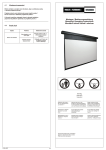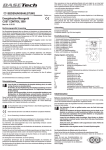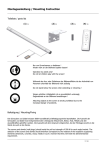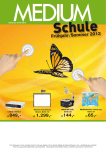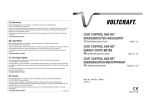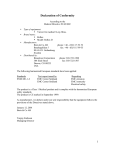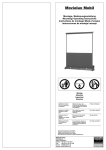Download Medium Rollux 2, 150x150cm
Transcript
Rollux 2 Montage-/ Bedienungsanleitung Mounting/ Operating instructions Instructions de montage/ Mode d´emploi Instrucciones de montaje/ manejo kg Wichtig Attention Important Atención Gefährlich für Kinder ! Nur von Erwachsenen zu bedienen ! Während des Aus- oder Einfahrens der Bildwandfläche ist der Aufenthalt von Personen nicht zulässig ! Wegen erhöhter Unfallgefahr ist es grundsätzlich untersagt, Gegenstände an der Bildwand anzubringen ! Hazardous to children ! Operation by adults only ! Do not stand near screen when extending or retracting ! Do not attach any objects on the screen (danger of injury) ! Dangereux pour les enfants ! Utilisation pour adultes seulement ! Ne pas se tenir à proximité lors du mouvement de l´écran ! Le fabricant interdit de fixer des objets quelconques sur l´écran (risque d´accident) ! Peligroso para niños ! Solo usable para adultos ! No se permite la estancia de personas durante el ascenso o descenso de la pantalla de proyección ! Evite fijar objetos en la pantalla, pues podría provocar algún accidente ! Technische Änderungen vorbehalten. Subject to alterations without notice. Modifications techniques sous réserve. Nos reservamos el derecho a realizar modificaciones. MEDIUM GmbH Willstätterstr. 7 40549 Düsseldorf Telefon: +49 (0) 211-52 76-0 Fax: +49 (0) 211-52 76-100 E-mail: [email protected] Internet: www.medium.de MEDIUM DÜSSELDORF * ZÜRICH * WIEN LONDON * MAILAND The Conference Company D Inhaltsverzeichnis 1. Allgemeine Sicherheitshinweise 1 2. 2.1 2.2 2.3 Montage Befestigungshinweise Teileliste Montage 2 2 2 2 3. 3.1 3.2 3.3 3.4 Bedienung Allgemeine Hinweise Bedienungsanleitung Bedienung bei Wandmontage Bedienung bei Deckenmontage 4 4 4 4 5 2. Montage 2.1 Befestigungshinweise - Die Schrauben und Dübel müssen 1000N Ausreißkraft je Befestigungswinkel standhalten. - Die Auswahl der Schrauben und Dübel muß entsprechend dem Untergrund (Mauerwerk, Beton, Holz, Metall) und dem Ausreißkräften getroffen werden. - Die Auswahl soll dem vorgehenden Anspruch entsprechen,bei der Montage sowohl an die Wand als auch an die Decke. 2.2 Teileliste (1) 1x (2) 1x 2.3 (3) 1x (4) 2x (5) 2x (6) 4x (7) 2x (8) 2x Montage (1) (2) Neigewinkel (2) mit den Laschen in die Tubenhalterung des Bildwandkastens (1) schieben. 2 (7) (2) Neigewinkel (2) mit zwei Blechschrauben (7) sichern. Wandmontage (3) Deckenmontage Wand- und Deckenhalterung (3) in gewünschter Position an die Wand oder an die Decke halten, mit Hilfe einer Wasserwaage regulieren und die Bohrlöcher markieren. (3) Löcher (für die Wand- und Deckenhalterung) der Markierung entsprechend bohren und Dübel einsetzen. (Siehe hierzu: 2.1 Befestigungshinweise) (1) (a) (2) (3) (b) (b) Bildwandkasten (1) mit Neigewinkel (2) auf Wand- und Deckenhalter (3) schieben und festhalten. Wichtig: Neigungsschnäpper (a) einrasten lassen ! Achten Sie darauf, daß die Bohrungen (b) übereinander liegen ! 3 3.4 Uso en caso de montaje en el techo (1) (8) (8) (4) (5) (6) (2) (6) (5) (4) Abrir la superficie de proyección: Estire del mango situado en la superficie de proyección (a) hacia abajo, hasta que note cómo encajan los elementos. (4) (5) (6) (2) (3) (6) (5) (4) Wandmontage: Mit Hilfe von Schrauben (4), Scheiben (5) und Tellerscheiben (6) Wand- und Deckenhalter (3) mit Neigewinkel (2) sichern. Zwei Blechschrauben (8) als zusätzliche Sicherung anbringen, da die Bildwand (1) bei Wandmontage nicht zum Neigen ausgelegt ist. (1) (2) (5) (6) (6) (5) (4) (4) (3) (4) (5) (6) (2) Inclinar la superficie de proyección: Sólo se puede inclinar la pantalla cuando está completamente abierta. Empuje la superficie de proyección por el mango (a) hacia atrás, pasando por el punto en el que ofrece resistencia, hasta que la pantalla se incline. La inclinación sin escalonamiento se puede ajustar posteriormente mediante tornillos (4) (véase también 2.3 Montaje). (6) (5) (4) Deckenmontage: Mit Hilfe von Schrauben (4), Scheiben (5) und Tellerscheiben (6) Wand- und Deckenhalter (3) mit Neigewinkel (2) sichern. 3. Bedienung 3.1 Allgemeine Hinweise Gefährlich für Kinder ! Nur von Erwachsenen zu bedienen ! Wegen erhöhter Unfallgefahr ist es grundsätzlich untersagt, Gegenstände an der Bildwand anzubringen ! 3.2 3.3 Bedienungsanleitung Bedienung bei Wandmontage Bei Wandmontage ist eine Neigung der Bildwandfläche nicht möglich! Cerrar la superficie de proyección: Sólo se puede cerrar la superficie de proyección en posición vertical (posición 0°). Tire del mango situado en la superficie de proyección (a) desde la posición inclinada hacia delante, hasta que llegue a la posición de 0° y note que los pestillos de inclinación encajan. Ausfahren der Bildwandfläche: Ziehen Sie die Bildwandfläche am Griff (a) nach unten, bis die Gelenke spürbar einrasten. (a) Empuje el mango situado en la superficie de proyección (a) hacia arriba, pasando por el punto en el que ofrece resistencia. A partir de una posición determinada la pantalla se enrolla automáticamente. Einfahren der Bildwandfläche: Ziehen Sie die Bildwandfläche am Griff (a) über den Widerstandspunkt nach oben. Ab einer gewissen Position rollt die Bildwandfläche automatisch ein. 4 17 3.4 Bedienung bei Deckenmontage (1) (8) (8) (4) (5) (6) (2) (6) (5) (4) (4) (5) (6) (2) (3) Ausfahren der Bildwandfläche: Ziehen Sie die Bildwandfläche am Griff (a) nach unten, bis die Gelenke spürbar einrasten. (6) (5) (4) Montaje en pared: Asegurar, mediante tornillos (4), arandelas (5) y arandelas de platillo (6), el soporte mural y de techo (3) con el ángulo de inclinación (2). Montar dos tornillos para chapa adicionales (8) para conseguir una fijación más segura, puesto que la pantalla de proyección (1) no está diseñada para ser inclinada en caso de montaje mural. (1) (2) (5) (6) (6) (5) (4) (4) (3) (4) (5) (6) (2) Neigen der Bildwandfläche: Neigung der Bildwandfläche nur in komplett ausgefahrener Position! Drücken Sie die Bildwandfläche am Griff (a) über den Widerstandspunkt nach hinten, bis die Bildwandfläche sich neigt. Stufenlose Neigung kann über Schrauben (4) nachjustier werden (siehe 2.3 Montage). (6) (5) (4) Montaje en el techo: Asegurar, mediante tornillos (4), arandelas (5) y arandelas de platillo (6), el soporte mural y de techo (3) con el ángulo de inclinación (2). 3. Uso 3.1 Indicaciones generales Peligroso para niños ! Solo usable para adultos ! Evite fijar objetos en la pantalla, pues podría provocar algún accidente ! 3.2 Indicaciones de uso 3.3 Uso en caso de montaje mural En caso de montaje mural no se puede inclinar la pantalla. Einfahren der Bildwandfläche: Das Einfahren der Bildwandfläche darf nur in gerader Position (0° -Stellung) erfolgen ! Ziehen Sie die Bildwandfläche aus geneigter Position am Griff (a) nach vorne in die 0° Stellung, bis der Neigungsschnäpper spürbar einrastet. Abrir la superficie de proyección: Estire del mango situado en la superficie de proyección (a) hacia abajo, hasta que note cómo encajan los elementos. (a) Cerrar la superficie de proyección: Empuje el mango situado en la superficie de proyección (a) hacia arriba, pasando por el punto en el que ofrece resistencia. A partir de una posición determinada la pantalla se enrolla automáticamente. 16 Ziehen Sie die Bildwandfläche am Griff (a) über den Widerstandspunkt nach oben. Ab einer gewissen Position rollt die Bildwandfläche automatisch ein. 5 GB List of contents (7) 1. General safety instructions 1 2. 2.1 2.2 2.3 Installation Notes on mounting and securing the screen Parts list Installation 6 6 6 6 3. 3.1 3.2 3.3 3.4 Operation General instructions Operating instructions Operating the screen when wall-mounted Operating the screen when ceiling-mounted 8 8 8 8 9 (2) Asegurar el ángulo de inclinación (2) con dos tornillos para chapa (7). 2. Installation 2.1 Notes on mounting and securing the screen Montaje mural - Ensure that screws and wall plugs used for mounting and securing the screen are capable of resisting a pull-out force of 1000N per mounting bracket. - The selection of the screws and dowels must correspond to the subsoil (brickwork, concrete, wood, metal) and the tensions in such a manner that they meet the aforementioned requirements of wall and ceiling mounting. 2.2 Parts list (3) (1) 1x Montaje en el techo (2) 1x (3) 1x (4) 2x (5) 2x (6) 4x (7) 2x (8) 2x Sujetar el soporte mural y de techo (3) en la posición deseada a) en la pared, b) en el techo, ajustarlo mediante un nivel de burbuja y marcar los puntos para taladrar. (3) 2.3 Taladrar los orificios (para el soporte mural y de techo) según las marcas efectuadas anteriormente e introducir los tacos. (véase también: 2.1 Indicaciones para la fijación) Installation (1) (1) (a) (2) (2) (3) (b) Slide the tilt bracket (2) with the tabs into the tube holder of the screen case (1). (b) Colocar el marco mural (1) con el ángulo de inclinación (2) sobre el soporte mural y de techo (3) y sujetarlo. Importante: Los pestillos de inclinación (a) deben quedar encajados. Procurar que los orificios taladros (b) se solapen. 6 15 E Índice (7) 1. Advertencias generales de Seguridad 2. 2.1 2.2 2.3 Montaje Indicaciones para la fijación Lista de piezas Montaje 14 14 14 14 3. 3.1 3.2 3.3 3.4 Uso Indicaciones generales Indicaciones de uso Uso en caso de montaje mural Uso en caso de montaje en el techo 16 16 16 16 17 2. Montaje 2.1 Indicaciones para la fijación 1 (2) Secure the tilt bracket (2) with two self-tapping screws (7). Wall mounting - Los tornillos y tacos deberán resistir una fuerza de arranque de 1000N por cada soporte angular. - La selección de los tornillos y los tarugos depende del tipo de pared y techo (mampostería, hormigón, madera, metal) y de las fuerzas de arranque. - La selección debe tener en cuenta la exigencia arriba formulada, en el montaje tanto en la pared como también en el techo. 2.2 Lista de piezas (1) 1x (3) Ceiling mounting (2) 1x (3) 1x (4) 2x (5) 2x (6) 4x (7) 2x (8) 2x Hold the wall and ceiling bracket (3) in the desired position on the wall a) or on the ceiling b) ; use a spirit level to ensure optimum alignment and then use a pencil to mark the respective boreholes as shown. (3) 2.3 Drill holes according to the corresponding marking, then insert wall plugs. (see section 2.1 "Notes on mounting and securing the screen") Montaje (1) (1) (a) (2) (3) (2) (b) Introducir el ángulo de inclinación (2) con las piezas de unión en el soporte de tubos del marco mural (1). (b) Slide the screen case (1) with tilt bracket (2) onto the wall and ceiling bracket (3) and hold in place. Important: allow the tilt catch (a) to engage ! Ensure that the boreholes (b) are correctly aligned with each other ! 14 7 3.4 Maniement lors de montage plafond (1) (8) (8) (4) (5) (6) (2) (6) (5) (4) (4) (5) (6) (2) (3) Déroulement de l´écran: Tirer la toile vers le bas par la poignée (a) jusqu´à l´encliquetage des articulations. (6) (5) (4) Wall mounting: Use screws (4), washers (5) and curved washers (6) to secure the wall and ceiling bracket (3) to the tilt bracket (2). Fit two self-tapping screws (8) for additional retention in view of the fact that the screen (1) is not designed for tilting when wall-mounted. (1) (2) (5) (6) (6) (5) (4) (4) (3) (4) (5) (6) (2) (6) (5) (4) Inclinaison de l´écran: N´incliner l´écran que quant la toile est entièrement déroulée. A l´aide de la poignée (a), pousser l´écran vers l´arrière au-delà du point de résistance jusqu´à ce qu´il s´incline. Des vis (4) permettent le réglage de l´inclinaison en continu (voir "2.3 Montage"). Ceiling mounting: Use screws (4), washers (5) and curved washers (6) to secure the wall and ceiling bracket (3) to the tilt bracket (2). 3. Operation 3.1 General instructions Hazardous to children ! Operation by adults only ! Do not attach any objects on the screen (danger of injury) ! 3.2 Operating instructions 3.3 Operating the screen when wall-mounted If wall-mounted, it is not possible to tilt the screen surface ! Enroulement de l´écran: N´enrouler l´écran que toile parfaitement à la verticale (position 0°). Tirer l´écran vers l´avant en position 0° par la poignée (a) jusqu´à l´encliquetage du cran d´inclinaison. Drawing out the screen surface: Use the handle (a) to draw the screen downwards until the scissor joints at the rear perceptibly engage. (a) Retracting the screen surface: Use the handle (a) to pull the screen upwards over the resistance point. Once a certain position has been reached, the screen surface then retracts upwards automatically. Tirer la toile vers le haut par la poignée (a) au-delà du point de résistance. A partir d´une certaine position, la toile s´enroule automatiquement. 8 13 3.4 Operating the screen when ceiling-mounted (1) (8) (8) (4) (5) (6) (2) (6) (5) (4) (4) (5) (6) (2) (3) Drawing out the screen surface: Use the handle (a) to draw the screen downwards until the scissor joints at the rear perceptibly engage. (6) (5) (4) Montage mural: Fixer le support mural ou plafonnier (3) ainsi que le profilé d´inclinaison (2) au moyen de vis (4) en interposant des rondelles plates (5) et coniques (6). Implanter deux vis à tôle (8) en guise de fixation supplémentaire, l´écran (1) n´étant pas inclinable en cas de montage mural. (1) (2) (5) (6) (6) (5) (4) (4) (3) (4) (5) (6) (2) Tilting the screen surface: Only tilt the screen surface when it is fully drawn out and the scissor joints have engaged ! Use the handle (a) to press the screen surface backwards past the resistance point until the screen surface is tilted. You can freely adjust the angle of tilt via the screws (4) (see Section 2.3, "Installation"). (6) (5) (4) Montage au plafond: Bloquer le support mural ou plafonnier (3) ainsi que le profilé d´inclinaison (2) au moyen de vis (4) en interposant des rondelles plates (5) et coniques (6). 3. Utilisation 3.1 Consignes générales Dangereux pour les enfants ! Utilisation pour adultes seulement ! Le fabricant interdit de fixer des objets quelconques sur l´écran (risque d´accident) ! 3.2 Instructions de service 3.3 Maniement lors de montage mural En cas de montage mural, l´écran n´est pas inclinable. Retracting the screen surface: The screen surface may only be retracted when not in tilted state (i.e. when it is in the "0° - position") ! To retract the screen surface, first use the handle (a) to pull it forwards from tilted position towards the "0° - position" until the tilt catch perceptibly engages. Déroulement de l´écran: Tirer la toile vers le bas par la poignée (a) jusqu´à l´encliquetage des articulations. (a) Enroulement de l´écran: Tirer la toile vers le haut par la poignée (a) au-delà du point de résistance. A partir d´une certaine position, la toile s´enroule automatiquement. Use the handle (a) to pull the screen upwards over the resistance point. Once a certain position has been reached, the screen surface then retracts upwards automatically. 12 9 F Sommaire (7) 1. Consignes générales de Sécurité 2. 2.1 2.2 2.3 Montage Consignes de fixation Liste des pièces Montage 10 10 10 10 3. 3.1 3.2 3.3 3.4 Utilisation Consignes générales Instructions de service Maniement lors de montage mural Maniement lors de montage plafond 12 12 12 12 13 1 (2) Fixer le profilé d´inclinaison (2) au moyen de deux vis à tôle (7). 2. Montage 2.1 Consignes de fixation Montage mural - Les vis et les chevilles doivent résister à une force d´arrachement de 1000N par équerre de fixation. - Le choix des vis et des chevilles doit être effectué en fonction du support (maçonnerie, béton, bois, métal) et des forces d'arrachement. - Le matériel choisi doit être conforme à l'exigence indiquée ci-dessus, qu'il s'agisse de montage mural ou au plafond. 2.2 Liste des pièces (1) 1x (3) Montage plafond (2) 1x (3) 1x (4) 2x (5) 2x (6) 4x (7) 2x (8) 2x Appliquer le support mural ou plafonnier (3) à l´endroit voulu, a) contre le mur / b) au plafond, l´orienter à l´aide d´un niveau à bulle et marquer l´emplacement des trous de perçage. (3) 2.3 Percer les trous (pour le support mural ou plafonnier) ainsi repérés et implanter les chevilles. (voir à cet effet: " 2.1 Consignes de fixation") Montage (1) (1) (a) (2) (2) (3) (b) Glisser les pattes du profilé d´inclinaison (2) sur le support du carter d´écran (1). (b) Glisser le carter d´écran (1) ainsi que le profilé d´inclinaison (2) sur le support mural ou de plafond (3) et le maintenir en place. Important: Faire encliqueter le cran d´inclinaison (a). Veiller à ce que les trous (b) soient bien superposés. 10 11
This document in other languages
- français: Medium Rollux 2, 150x150cm
- español: Medium Rollux 2, 150x150cm
- Deutsch: Medium Rollux 2, 150x150cm










